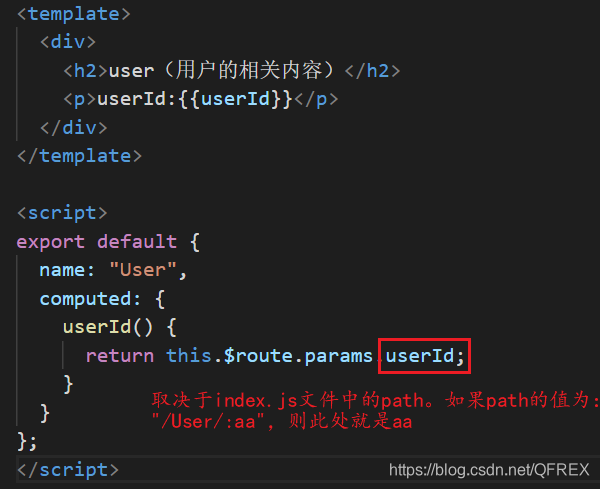1. $route.params
(1)新建组件
新建一个User.vue文件,添加
1
2
3
4
5
6
7
8
9
10
11
12
13
14
15
16
17
| <template>
<div>
<h2>user(用户的相关内容)</h2>
<p>userId:{{userId}}</p>
</div>
</template>
<script>
export default {
name: "User",
computed: {
userId() {
return this.$route.params.userId;
}
}
};
</script>
|

(2)设置映射
打开index.js文件,添加如下代码:
1
2
3
4
5
| {
path: "/User/:userId",
component: User,
name: User,
}
|
(3)App.js
打开App.js文件

2. $route.query
(1)新建组件:profile.vue,添加如下代码
1
2
3
4
5
6
7
8
9
10
11
12
| <template>
<div>
<h2>profile</h2>
<p>{{$route.query}}</p>
<p>{{$route.query.name}}</p>
</div>
</template>
<script>
export default {
name: "profile"
};
</script>
|
$route.query是一个对象,里面是页面传过来的数据
(2)设置映射
打开index.js文件,添加如下代码
1
2
| const profile = () =>
import ("../components/Profile.vue");
|
1
2
3
4
5
| {
path: "/profile",
name: profile,
component: profile,
}
|
(3)打开App.vue,添加如下代码
1
2
3
4
| <router-link
:to="{path: '/profile',query: {name:'WRM',sex: 'girl',height: '166'}}"
tag="button"
>profile</router-link>
|
3.如果不用<router-link>标签该如何传递参数?
例如,把原来的
1
2
3
4
| <router-link
:to="{path: '/profile',query: {name:'WRM',sex: 'girl',height: '166'}}"
tag="button"
>profile</router-link>
|
替换为button
1
| <button @click="profileClick">profile</button>
|
在methods里添加:
1
2
3
4
5
6
7
8
9
10
| profileClick() {
this.$router.push({
path: "/profile",
query: {
name: "WRM",
sex: "girl",
height: "166"
}
});
}
|
其余的和2.一样



